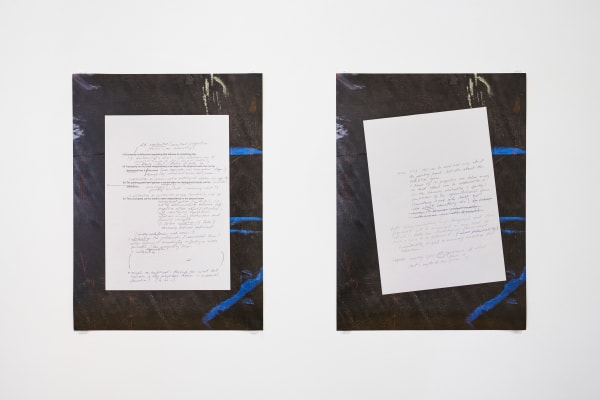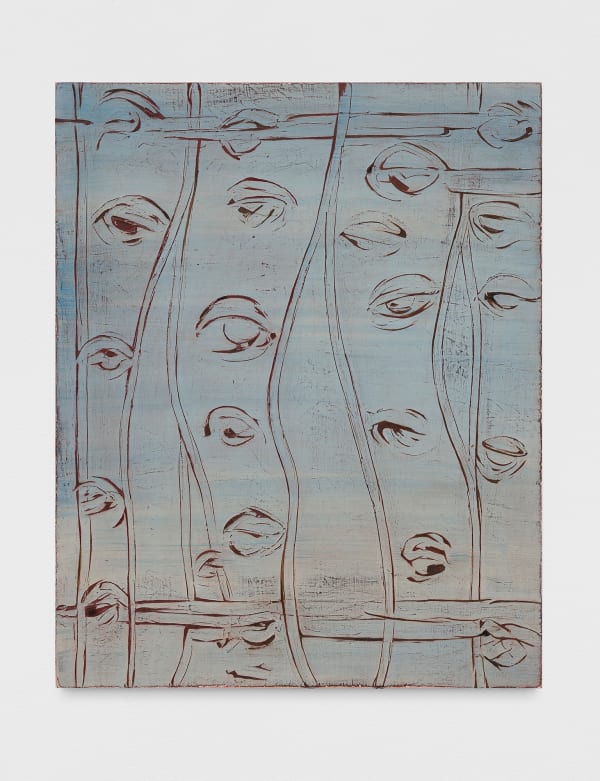properties without object Iulia Nistor
Past exhibition
Overview
Mendes Wood DM New York
Feb 3 - Mar 5, 2023
Mendes Wood DM is delighted to present properties without object, Iulia Nistor’s third solo exhibition with the gallery and her first in New York. The exhibition consists of new works from Nistor’s Evidence Paintings series, all 50 x 40 centimeters, painted in oil on wooden panels. Each is titled with coordinates, suggesting not only the representational function, but also documentary specificity, of paintings which rarely picture anything we can automatically name.
Paint is used with a diverse range of techniques, applied with a fine brush in painstaking detail or with broad gestures. Hard-edged forms cede to organic scumbling. Deep illusionistic spaces, evoked by geometric lines of perspective, contrast with marks which emphasize painting’s limitations to its surface. Trompe l’oeil plays sly games with our habitual perceptions. Dried paint is removed with a sanding device, subverting Nistor’s intentions, producing unforeseen configurations and textures, and reducing multiple layers of paint to ground.
Irreducible to any singular style, these expressive resources are positioned to represent the properties of certain things, perhaps an observed aspect of an object, a place, a person, or the space between them. Nistor’s purpose is not primarily to represent the things themselves but the qualities which they possess. This aim makes her paintings register less as representations than inquiries into the nature of representation itself, questioning the opaque relation between how something appears, how it is perceived, and how that duality can be pictorially rendered. How much of what we experience is a given of the environment, and how is it changed by the subjectivity which accompanies it? Does a painting, unlike a photograph, need to depart from the ostensible form of its subject to, paradoxically, achieve a true likeness of it?
Nistor often proceeds through gestures of subtraction, isolating a property of an object by eliminating aspects of it. The specificities of her practice correspond to the specificity of the phenomena they are used to capture.
Alongside her paintings, for the first time, Nistor exhibits a pair of photographs, each showing one side of an A4 sheet of paper, upon which a sequence of propositions is printed. These are attempts to define the relationship between objects and the properties which seem to adhere to them. The spare sentences, phrased in objective, philosophical language, have been edited by queries and remarks, written in pencil and ballpoint pen, in the artist’s hand. This process of revision and redefinition, preempting the demand for a categorical answer, reflects the artist’s process in painting.
In both photographs, the sheets appear on a black studio surface. One rests parallel to its frame, resembling an aperture, while the other lies tilted, negating this illusion. The abstractions of language qualify—or are qualified by—the materiality of the wooden surface, much like those upon which Nistor paints, stained with traces of the artist’s process. A window into Nistor’s conceptual method doubles as a formal metaphor for the axis, central to her practice, between the given and the made.
Paint is used with a diverse range of techniques, applied with a fine brush in painstaking detail or with broad gestures. Hard-edged forms cede to organic scumbling. Deep illusionistic spaces, evoked by geometric lines of perspective, contrast with marks which emphasize painting’s limitations to its surface. Trompe l’oeil plays sly games with our habitual perceptions. Dried paint is removed with a sanding device, subverting Nistor’s intentions, producing unforeseen configurations and textures, and reducing multiple layers of paint to ground.
Irreducible to any singular style, these expressive resources are positioned to represent the properties of certain things, perhaps an observed aspect of an object, a place, a person, or the space between them. Nistor’s purpose is not primarily to represent the things themselves but the qualities which they possess. This aim makes her paintings register less as representations than inquiries into the nature of representation itself, questioning the opaque relation between how something appears, how it is perceived, and how that duality can be pictorially rendered. How much of what we experience is a given of the environment, and how is it changed by the subjectivity which accompanies it? Does a painting, unlike a photograph, need to depart from the ostensible form of its subject to, paradoxically, achieve a true likeness of it?
Nistor often proceeds through gestures of subtraction, isolating a property of an object by eliminating aspects of it. The specificities of her practice correspond to the specificity of the phenomena they are used to capture.
Alongside her paintings, for the first time, Nistor exhibits a pair of photographs, each showing one side of an A4 sheet of paper, upon which a sequence of propositions is printed. These are attempts to define the relationship between objects and the properties which seem to adhere to them. The spare sentences, phrased in objective, philosophical language, have been edited by queries and remarks, written in pencil and ballpoint pen, in the artist’s hand. This process of revision and redefinition, preempting the demand for a categorical answer, reflects the artist’s process in painting.
In both photographs, the sheets appear on a black studio surface. One rests parallel to its frame, resembling an aperture, while the other lies tilted, negating this illusion. The abstractions of language qualify—or are qualified by—the materiality of the wooden surface, much like those upon which Nistor paints, stained with traces of the artist’s process. A window into Nistor’s conceptual method doubles as a formal metaphor for the axis, central to her practice, between the given and the made.
Iulia Nistor (b. 1985, Bucharest, Romania) lives and works in São Paulo, Brazil. She graduated from the Städelschule in Frankfurt, Germany and has recently received a PhD in Philosophy.
Her solo exhibitions include: Two Forward, Three Back, Mendes Wood DM, Brussels, Belgium (2019); Revenge of the Given, Plan B, Berlin, Germany (2019); Eary Poise, Mendes Wood DM, São Paulo, Brazil (2017); canary in a coal mine, Plan B, Berlin, Germany (2017); Before Interpretation, Galeria Electroputere, Craiova, Romania (2015); .../.../..., Strabag Kunstforum, Vienna, Austria (2015); and (i)... (ii)... (iii)... (iv)..., Aiurart Contemporary Art Space, Bucharest, Romania (2014).
Nistor's work has also been presented in recent group exhibitions such as BETAMAX, Nils Staerk Gallery, Copenhagen, Denmark (2022); Living Together–Crossing Borders, 4th Mediterranean Biennale, Haifa, Israel (2021); Secret Wing, Art Encounters Biennial, Timisoara, Romania (2021); Rethinking the Image of the World / Projects and Sketches, Ianchelevichi Museum, La Louvière, Belgium (2019); Spaţiu (Continuare şi sfârşit): Iulia Nistor & Achraf Touloub, Scena9, Bucharest, Romania (2019); and After Rubens, Städel Museum, Frankfurt, Germany (2018).
Her solo exhibitions include: Two Forward, Three Back, Mendes Wood DM, Brussels, Belgium (2019); Revenge of the Given, Plan B, Berlin, Germany (2019); Eary Poise, Mendes Wood DM, São Paulo, Brazil (2017); canary in a coal mine, Plan B, Berlin, Germany (2017); Before Interpretation, Galeria Electroputere, Craiova, Romania (2015); .../.../..., Strabag Kunstforum, Vienna, Austria (2015); and (i)... (ii)... (iii)... (iv)..., Aiurart Contemporary Art Space, Bucharest, Romania (2014).
Nistor's work has also been presented in recent group exhibitions such as BETAMAX, Nils Staerk Gallery, Copenhagen, Denmark (2022); Living Together–Crossing Borders, 4th Mediterranean Biennale, Haifa, Israel (2021); Secret Wing, Art Encounters Biennial, Timisoara, Romania (2021); Rethinking the Image of the World / Projects and Sketches, Ianchelevichi Museum, La Louvière, Belgium (2019); Spaţiu (Continuare şi sfârşit): Iulia Nistor & Achraf Touloub, Scena9, Bucharest, Romania (2019); and After Rubens, Städel Museum, Frankfurt, Germany (2018).
Works
-
 Iulia Nistor, Evidence E6 F9 A2, 2022
Iulia Nistor, Evidence E6 F9 A2, 2022 -
 Iulia Nistor, Evidence E9 W4 A/P0, 2022
Iulia Nistor, Evidence E9 W4 A/P0, 2022 -
 Iulia Nistor, Evidence L7 F2 A/P0, 2022
Iulia Nistor, Evidence L7 F2 A/P0, 2022 -
 Iulia Nistor, Evidence E8 F0 A1, 2022
Iulia Nistor, Evidence E8 F0 A1, 2022 -
 Iulia Nistor, Evidence L5 W8 P1, 2022
Iulia Nistor, Evidence L5 W8 P1, 2022 -
 Iulia Nistor, Evidence E/L0 W9 A5, 2022
Iulia Nistor, Evidence E/L0 W9 A5, 2022 -
 Iulia Nistor, Evidence L8 W1 P8, 2022
Iulia Nistor, Evidence L8 W1 P8, 2022 -
 Iulia Nistor, Evidence L1 W1 P1, 2022
Iulia Nistor, Evidence L1 W1 P1, 2022 -
 Iulia Nistor, Evidence L2 F6 A5, 2022
Iulia Nistor, Evidence L2 F6 A5, 2022 -
 Iulia Nistor, Evidence E1 W7 A1, 2022
Iulia Nistor, Evidence E1 W7 A1, 2022 -
 Iulia Nistor, Evidence L6 F2 A9, 2023
Iulia Nistor, Evidence L6 F2 A9, 2023 -
 Iulia Nistor, Untitled (properties without object), 2023
Iulia Nistor, Untitled (properties without object), 2023 -
 Iulia Nistor, Evidence L7 F7 A3, 2022
Iulia Nistor, Evidence L7 F7 A3, 2022 -
 Iulia Nistor, Evidence L2 F/W0 A9, 2022
Iulia Nistor, Evidence L2 F/W0 A9, 2022 -
 Iulia Nistor, Evidence L3 W2 P8, 2022
Iulia Nistor, Evidence L3 W2 P8, 2022 -
 Iulia Nistor, Evidence E9 F1 P3, 2022
Iulia Nistor, Evidence E9 F1 P3, 2022 -
 Iulia Nistor, Evidence L/E0 F4 A5, 2022
Iulia Nistor, Evidence L/E0 F4 A5, 2022 -
 Iulia Nistor, Evidence L4 F1 A7, 2023
Iulia Nistor, Evidence L4 F1 A7, 2023 -
 Iulia Nistor, Evidence L7 F9 P9, 2023
Iulia Nistor, Evidence L7 F9 P9, 2023
Installation Views





















